
The Genoa–Pisa railway is one of the trunk lines of the Italian railway network. It runs along the Ligurian coast from Genoa to Pisa through the Riviera di Levante and the Versilia. It passes through the cities of Massa, Carrara and La Spezia. South of Pisa the Pisa–Rome line continues along the Tyrrhenian coast to Rome. The line is double track and is fully electrified at 3,000 V DC. Passenger traffic is managed by Trenitalia.
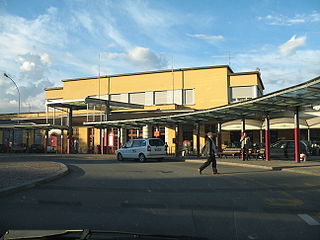
Biella San Paolo railway station is the main station serving the town and comune of Biella, in the Piedmont region, northwestern Italy. It is the junction of the Biella–Novara and Santhià–Biella railways.

Barletta railway station is the main station serving the city and comune of Barletta, in the region of Apulia, southern Italy. Opened in 1864, it forms part of the Adriatic Railway (Ancona–Lecce), and is also a junction station for two other, regional, lines, the Barletta–Spinazzola railway, and the Bari–Barletta railway, operated by Ferrotramviaria.

Treviglio railway station, also known as Treviglio centrale railway station is the main station serving the town and comune of Treviglio, in the region of Lombardy, northern Italy. Opened in 1878, it has a higher average number of passengers per day than Treviglio's other railway station, Treviglio Ovest.
The Rome–Ancona railway is a rail line in central Italy connecting the city of Ancona with Orte, and therefore with the capital city, Rome. The line crosses the Apennine Mountains from the Adriatic Sea to the Tyrrhenian Sea, passing through Foligno, Spoleto, and Terni.

The Adriatic railway is the railway from Ancona to Lecce that runs along the Adriatic Coast of Italy, following it almost all of the way. It is one of the main lines of the Italian rail system and links the northern cities with the most important productive areas of central and southern Italy.
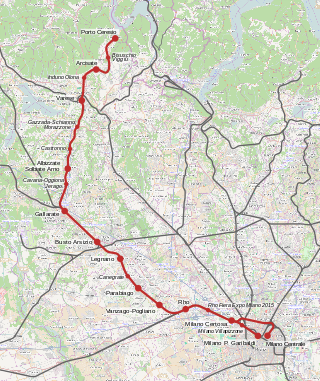
Porto Ceresio–Milan railway is a railway line in Lombardy, Italy. It uses the tracks of the Milan–Arona railway until Gallarate.

The Bologna–Ancona railway is an Italian railway that connects the city of Bologna with the city of Ancona, passing through the Po Valley to Rimini and along the Adriatic coast for the rest of the line.
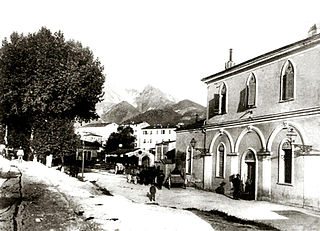
Carrara San Martino railway station, previously named Carrara Città, was a railway station common to two lines, now suppressed, located near the center of Carrara.

The Avenza–Carrara railway was a short line connecting the center of Carrara with the locality of Avenza, falling in the same municipality, on which there was and still there is a station of the Genoa-Pisa railway. Opened in 1866, the line constituted later an element of the Carrara Private Marble railway; after the closure of the latter it remained in service as goods connection until the closure to traffic in 1969. The definitive suppression was established by Decree of the President of the Republic no. 1459 of December 28, 1970.

The Ionian Railway is an Italian 472-kilometre (293-mile) long railway line that connects Taranto, with Sibari, Crotone and Reggio Calabria. The route operates through the regions of Apulia, Basilicata and Calabria. The route largely follows the coast of the Ionian Sea.
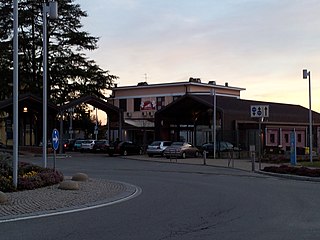
Cossato railway station is the train station serving the town and comune of Cossato, in the Piedmont region of northwestern Italy. It is the junction of the Biella–Novara.
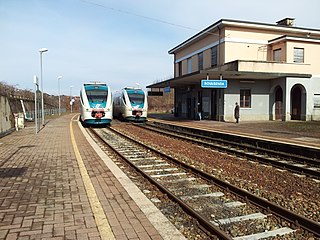
Rovasenda railway station is one of two train stations serving the comune of Rovasenda, in the Piedmont region of northwestern Italy. It is the junction of the Biella–Novara. It also plays the role of interchange with station Rovasenda Alta of line Santhià–Arona.

Carpignano Sesia railway station is a railway station serving the comune of Carpignano Sesia, in the Piedmont region of northwestern Italy. The station is located on the Biella–Novara railway. The train services are operated by Trenitalia.
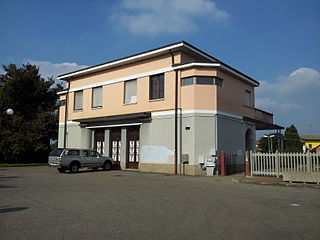
Casaleggio railway station is the train station serving the comune of Casaleggio, in the Piedmont region of northwestern Italy. It serves as the junction of the Biella–Novara.

Terni–Perugia–Sansepolcro railway is a railway line in Umbria, Italy. It was built by the Ferrovia Centrale Umbra The line, about 147 kilometres (91 mi) in length, connects Terni in southern Umbria with Sansepolcro, Tuscany, with stops in Todi, Perugia, Umbertide and Città di Castello. It is operated by Busitalia Sita Nord, a subsidiary of the Ferrovie dello Stato Italiane group.
The Parma–La Spezia railway is the railway line that connects Parma, Italy with the Genoa–Pisa railway near La Spezia over the Cisa Pass through the Apennines. The route is approximately 120 kilometres long. Its Italian name derives from the town of Pontremoli, one of the main towns it passes through.
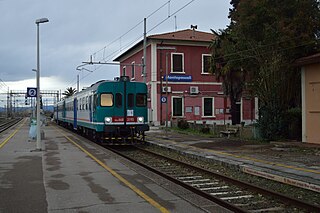
Montepescali railway station is an Italian railway station on the Tirrenica railway line, located in the village of Braccagni, at the bottom of the hill of Montepescali, near the city of Grosseto. It serves as a junction for services on the Siena-Grosseto line that connect here and follow the main line south into Grosseto.
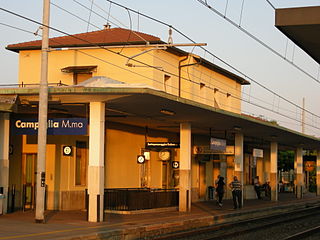
Campiglia Marittima railway station is an Italian railway station on the Tirrenica railway line. It serves as a junction for the line to Piombino that connects here with the Tirrenica railway.
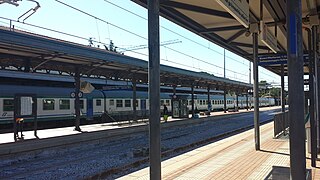
Cecina railway station is an Italian railway station on the Tirrenica railway line in Tuscany.























